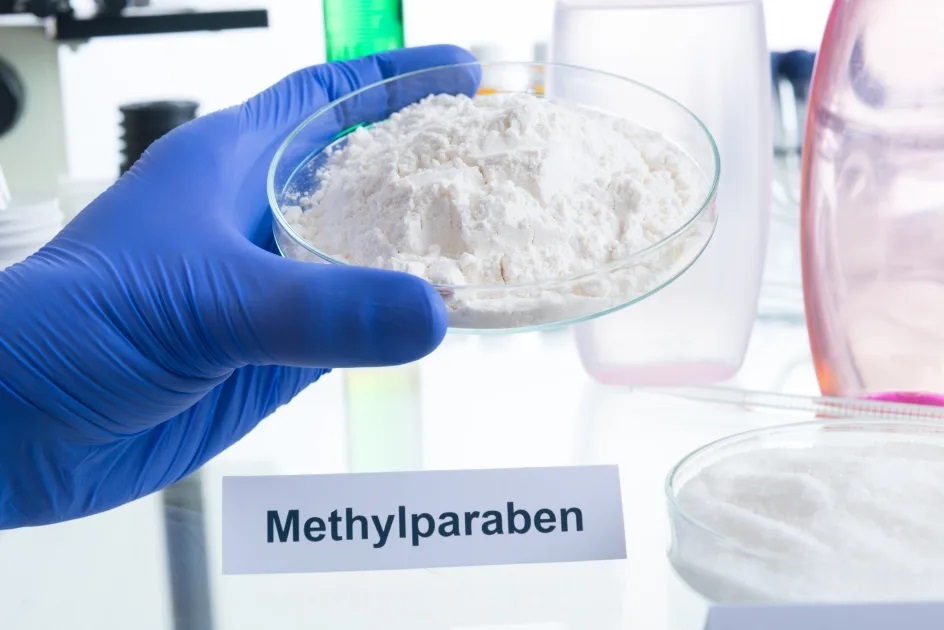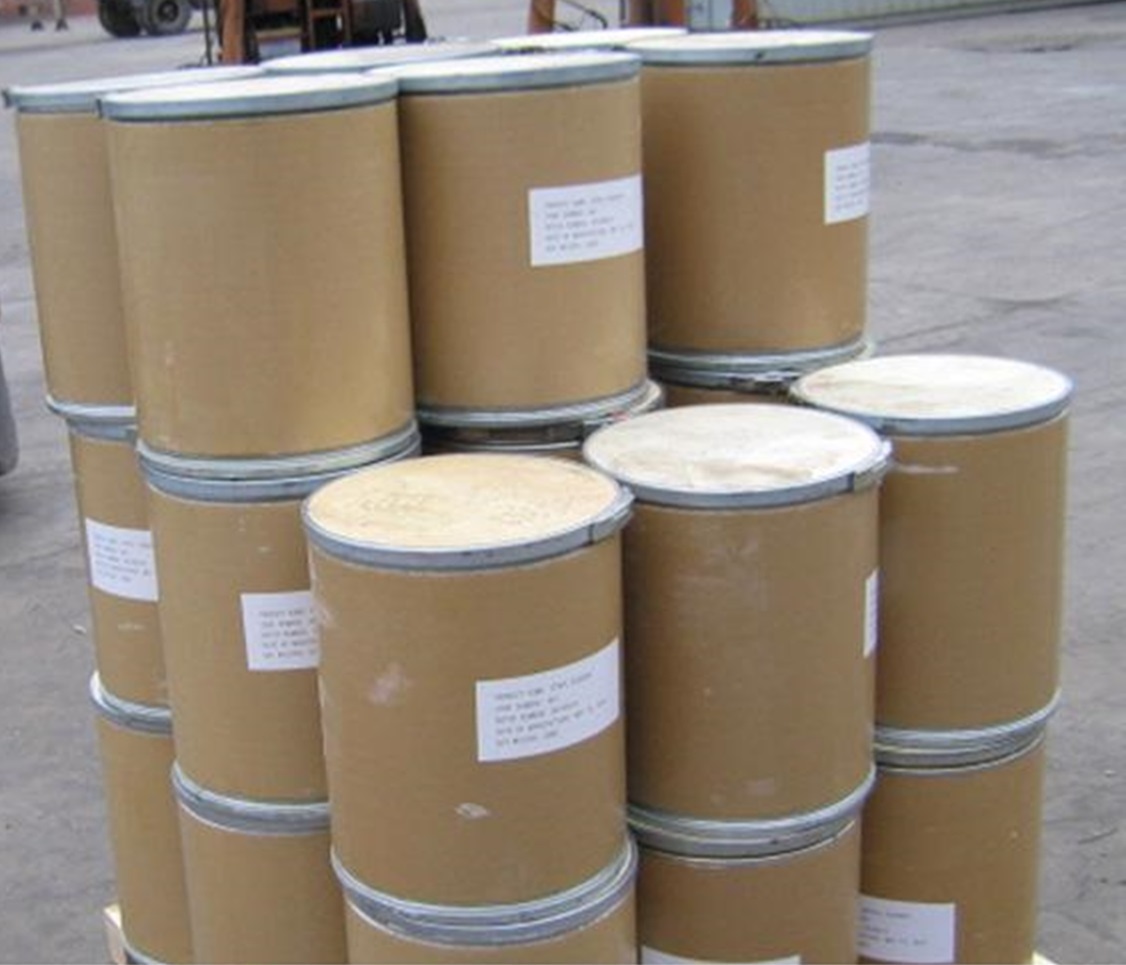We unleash your business potential by maximize the business innovation.
Send EmailBENZYLPARABEN, BASEPTOL, BENZYL PARABEN, Benzyl paraben, Benzyl Parasept, Benzylp-Hydrocybenzoate, Benzyl 4-hydroxybenzoate, 94-18-8
CAS: 94-18-8
Molecular Formula: C14H12O3
Names and Identifiers
| Name | Benzyl 4-hydroxybenzoate |
| Synonyms | BASEPTOL BENZYLPARABEN Benzyl paraben Benzyl Parasept Benzylp-Hydrocybenzoate benzyl-4-hydoxybenzoate Benzyl 4-hydroxybenzoate BENZYL P-HYDROXYBENZOATE BENZYL 4-HYDROXYBENZOATE 4-Hydroxybenzoic acid benzyl ester 4-Hxdroxybenzoic acid benzyl ester 4-HYDROXYBENZOIC ACID BENZYL ESTER Benzoicacid,4-hydroxy-,phenylmethylester |
| CAS | 94-18-8 |
| EINECS | 202-311-9 |
| InChI | InChI=1/C14H12O3/c15-13-8-6-12(7-9-13)14(16)17-10-11-4-2-1-3-5-11/h1-9,15H,10H2 |
Physico-chemical Properties
| Molecular Formula | C14H12O3 |
| Molar Mass | 228.24 |
| Density | 1.1799 |
| Melting Point | 109-112°C(lit.) |
| Boling Point | 170℃ |
| Flash Point | 167℃ |
| Water Solubility | 92mg/L(25 ºC) |
| Solubility | ethanol: soluble25mg/mL, clear, colorless |
| Vapor Presure | 0Pa at 25℃ |
| Appearance | Powder |
| Color | White to Almost white |
| BRN | 2115995 |
| pKa | 8.18±0.15(Predicted) |
| Storage Condition | Inert atmosphere,2-8°C;贮存于阴凉、干燥处,避免日晒、雨淋;有效贮存 期12个月。按一般化学品运输。 |
| Refractive Index | 1.5805 |
| MDL | MFCD00016471 |
| Physical and Chemical Properties | White crystalline powder, colorless liquid at high temperature. Slightly sweet aroma. |
| Use | As the main fragrance used in daily flavor, can also be used for food flavor |
Risk and Safety
| Hazard Symbols | Xi - Irritant |
| Risk Codes | 36/37/38 - Irritating to eyes, respiratory system and skin. |
| Safety Description | S26 - In case of contact with eyes, rinse immediately with plenty of water and seek medical advice. S36 - Wear suitable protective clothing. S37/39 - Wear suitable gloves and eye/face protection |
| UN IDs | 3077 |
| WGK Germany | 3 |
| RTECS | DH2691000 |
| TSCA | Yes |
| HS Code | 29181990 |
| Hazard Class | IRRITANT |
| Packing Group | III |
Standard
This product is benzyl-4-hydroxybenzoic acid. The content of C14H1203 shall be 98.0% to 102.0% based on the dry product.
Trait
- This product is white or milky white crystalline powder.
- This product is dissolved in methanol or ethanol, and is almost insoluble in water.
melting point
The melting point of this product (General 0612) is 111~113 "C.
Differential diagnosis
- in the chromatogram recorded under the content determination item, the retention time of the main peak of the test solution should be consistent with the retention time of the main peak of the reference solution.
- This product is dissolved and diluted with ethanol to make a solution containing about 5mg per l t n l, which is determined by UV-Vis spectrophotometry (General rule 0401), there is an absorption maximum at a wavelength of 260nm.
- The infrared absorption spectrum of this product should be consistent with that of the reference product (General rule 0402).
Exam
acidity
take 50% g of this product, add ethanol aqueous solution, shake, add 2 drops of Methyl red indicator solution, and use sodium hydroxide titration solution (0.lmol/L) titration to orange, consumption of sodium hydroxide titration solution (0.lmol/L) must not exceed 0.lm l.
chloride
take 2.0g of this product, add water 50ml,80 * C water bath heating for 5 minutes, let cool, filter; Take the filtrate 5.0ml, check according to law (General rule 0801), with standard sodium chloride solution 7. Compared with the control solution made of 0M l, it should not be more concentrated (0. 035%).
sulfate
take chloride and continue filtrate 2 5M K for inspection according to law (General rule 0802), with standard potassium sulfate solution 2 .4M l of control solution should not be more concentrated (0.024%).
Related substances
take this product, add the solvent [1% glacial acetic acid-methanol (40 :60)] dissolve and dilute to make the solution containing 1 mg per lm l, as the test solution; take 1 ml accurately, put it in a 100ml measuring flask, dilute to the scale with solvent, shake well, and use as a control solution. The appropriate amount of the reference substance of p-Hydroxybenzoic acid was accurately weighed, dissolved with a solvent and quantitatively diluted to prepare a solution containing 10mg per l of lm as a reference solution. According to the high performance liquid chromatography (General 0512) test, using phenylsilane bonded silica gel as filler, mobile phase A is 1% glacial acetic acid, mobile phase B is methanol; Gradient elution is carried out according to the following table, the detection wavelength was 254nm. Weigh appropriate amount of hydroxyphenyl butyl ester and hydroxyphenyl benzyl ester reference product, add solvent to dissolve and dilute to make a mixed solution containing 10 gm/ml each, as the system applicable solution, and take 20ul of the system applicable solution, note human liquid chromatograph, record chromatogram, separation degree between peak of hydroxyphenyl butyl ester and hydroxyphenyl benzyl ester should be not less than 3.0. Take the control solution 20u1, inject human liquid chromatograph, adjust the detection sensitivity, so that the peak height of the main component peak is about 25% of the full scale; Then take the sample solution, the control solution and the reference solution were injected into the liquid chromatograph, and the chromatograms were recorded. If there is a peak consistent with the retention time of the peak of p-Hydroxybenzoic acid in the chromatogram of the test solution, the peak area shall be calculated according to the external standard method. The Peak area of p-Hydroxybenzoic acid shall not exceed 1.0%, and the peak area of other individual impurities shall not be greater than that of the control. 0.5 times (0.5%) of the main peak area of the solution, and the sum of the peak areas of other impurities shall not be greater than the main peak area of the control solution (1.0%).
loss on drying
take this product, put it in a silica gel dryer, and dry it under reduced pressure to constant weight. The weight loss shall not exceed 0831 (general rule).
ignition residue
The l .O g of this product shall be taken for inspection according to law (General rule 0841), and the remaining residue shall not exceed.
precious metals
The remaining residue under the item of taking the ignition residue is determined by law (General 0821 second method>), and the heavy metal content shall not exceed 20 parts per million.
Content determination
measured by high performance liquid chromatography (General 0512).
- chromatographic conditions and system applicability test using phenylsilane bonded silica gel as filler, 1% glacial acetic acid as mobile phase A, methanol as mobile Phase B, gradient elution was carried out as follows, detection wavelength 254mn. Take the system applicable solution 20 u1 under the item of related substances, inject human liquid chromatography, record the chromatogram, and the separation degree between the peak of hydroxyphenyl butyl ester and hydroxyphenyl benzyl ester should not be less than 3 .0.
- determination of the appropriate amount of this product, precision weighing, plus solvent [1% glacial acetic acid-methanol (40:60)] Dissolved and quantitatively diluted to make about 0 per 1 ml. lmg solution, the precision of 20 u1, injection of human liquid chromatography, record the chromatogram; An appropriate amount of hydroxyphenyl benzyl ester reference substance, the same method for determination. According to the external standard method to calculate the peak area, that is.
Category
pharmaceutical excipients, bacteriostatic agents.
Storage
sealed storage.
Preparation method
1. Preparation of methyl p-hydroxybenzoate
Add 773kg of p-hydroxybenzoic acid and 220L of anhydrous methanol into the reactor, then slowly add 2.2L of concentrated sulfuric acid with vigorous stirring. After adding sulfuric acid, heat and reflux at 55 ℃ for 10-12 hours with stirring. Transfer the reaction solution into a reactor containing 20000L of ice water mixture and let it stand to allow crystallization to precipitate. Filtration, the filtrate is sent to the methanol recovery and fractionation tower to recover methanol. The filtered crude product is washed once with water, then washed once with sodium carbonate, and washed once again with water to obtain the crude product. After drying, it becomes an industrial product. The crude product is recrystallized in a mixed solvent of benzyl alcohol, filtered out, and dried in a vacuum dryer with calcium chloride desiccant to obtain the product.
2. Preparation of benzyl p-hydroxybenzoate
Add 710kg of methyl p-hydroxybenzoate and approximately 3000L of benzyl alcohol 162kg of potassium carbonate to the reaction vessel, stir, reduce pressure, heat to 110 ℃ under 5.32kPa pressure, and maintain this temperature while stirring for 20 hours. Then reduce pressure to 1.3kPa and evaporate excess benzyl alcohol. After the benzyl alcohol is almost evaporated, stop heating and restore normal pressure. Add 2000L of 3% dilute sulfuric acid to the residual reactants, stir well, filter, wash several times with water, drain, and dry to obtain the product. Purified product obtained from methanol recrystallization.
Reference Information
| LogP | 2.185 at 25℃ |
| Use | as a main fragrance used in daily flavor, can also be used for food flavor |




